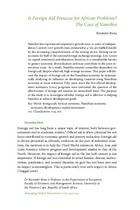Is foreign aid panacea for African problems? The case of Namibia
Is foreign aid panacea for African problems? The case of Namibia
| dc.contributor.author | Rena, Ravinder | |
| dc.date.accessioned | 2017-02-20T10:20:01Z | |
| dc.date.available | 2017-02-20T10:20:01Z | |
| dc.date.issued | 2013 | |
| dc.identifier.citation | Rena, R. (2013). Is foreign aid panacea for African problems? The case of Namibia. Managing Global Transitions, 11(3): 223-241 | en_US |
| dc.identifier.citation | Rena, R. (2013). Is foreign aid panacea for African problems? The case of Namibia. Managing Global Transitions, 11(3): 223-241 | |
| dc.identifier.issn | 1581-6311 | |
| dc.identifier.uri | http://hdl.handle.net/10566/2555 | |
| dc.description.abstract | Namibia has experienced impressive growth since 21 years of independence. Current gdp growth rates, estimated at 4–5%, are fuelled mainly by the increasing competitiveness of the mining sector. Mining sector accounts for half of the national foreign exchange earnings. Low scores on capital investment and education, however, is a considerable barrier to greater economic diversification and may contribute to the poor innovation score. As a result, Namibia remains somewhat dependent on foreign aid, despite relatively high average incomes. This paper will discuss the impact of foreign aid on the Namibian economy by systematically analyzing its influence on developing countries using Namibian economy as focus reference. Fifty years since the first official development assistance (oda) programs were instituted, the question of the effectiveness of foreign aid remains an unresolved issue. The purpose of the study is to investigate whether foreign aid is effective in helping Namibia to achieve development goals. | en_US |
| dc.description.abstract | Namibia has experienced impressive growth since 21 years of independence. Current gdp growth rates, estimated at 4-5%, are fuelled mainly by the increasing competitiveness of the mining sector. Mining sector accounts for half of the national foreign exchange earnings. Low scores on capital investment and education, however, is a considerable barrier to greater economic diversification and may contribute to the poor innovation score. As a result, Namibia remains somewhat dependent on foreign aid, despite relatively high average incomes. This paper will discuss the impact of foreign aid on the Namibian economy by systematically analyzing its influence on developing countries using Namibian economy as focus reference. Fifty years since the first official development assistance (oda) programs were instituted, the question of the effectiveness of foreign aid remains an unresolved issue. The purpose of the study is to investigate whether foreign aid is effective in helping Namibia to achieve development goals. | |
| dc.language | en_US | |
| dc.language.iso | en_US | en_US |
| dc.publisher | University of Primorska | en_US |
| dc.publisher | University of Primorska | |
| dc.rights | Managing Global Transitions is an open access journal distributed under the terms of the Creative Commons CC BY-NC-ND 4.0 License. No article submission or article processing fees are charged. | |
| dc.subject | Foreign aid | en_US |
| dc.subject | African economy | en_US |
| dc.subject | Namibia | en_US |
| dc.subject | Economic development | en_US |
| dc.subject | Foreign aid | |
| dc.subject | African economy | |
| dc.subject | Namibia | |
| dc.subject | Economic development | |
| dc.title | Is foreign aid panacea for African problems? The case of Namibia | en_US |
| dc.title | Is foreign aid panacea for African problems? The case of Namibia | |
| dc.type | Article | en_US |
| dc.type | Article | |
| dc.privacy.showsubmitter | FALSE | |
| dc.status.ispeerreviewed | TRUE | |
| dc.description.accreditation | International Bibliography of Social Sciences |

